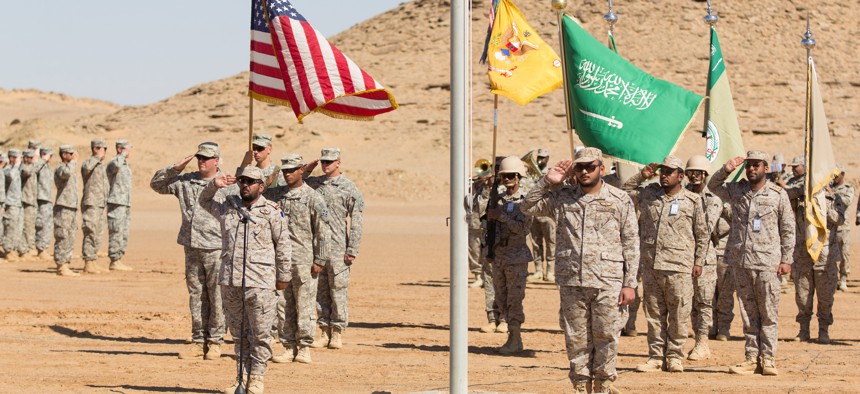
U.S. and Saudi Arabian forces conduct a closing ceremony for Exercise Friendship and Iron Hawk 14 on April 14th, 2014, near Tabuk, Saudi Arabia. N.Y. Army National Guard photo by Sgt. Harley Jelis
The ISIS Fight Is Reshaping US Arms Exports to Its Partners
A slight uptick in approvals for sales to anti-ISIS coalition partners has masked a big shift in the kinds of weapons being sold.
By raw value, the $45.8 billion in U.S. arms sales approved in the past 16 months for countries battling the Islamic State and other militants is just a bit more than the $43 billion approved for the same countries over the same duration before coalition airstrikes began. But the kinds of weapons going to those countries — Iraq, Saudi Arabia, and others — have shifted dramatically.
The earlier deals focused largely on longer-term investments, maintaining existing equipment, and building up weapons stocks. The more recent ones have been largely for tactical equipment: bombs, missiles, tanks, armored trucks and antitank weapons needed on the battlefield today, according to documents and U.S. government officials.
“There’s certainly the political will inside the U.S. government to ensure that our partners have what they need as quickly as they can get it,” Gregory Kausner, deputy assistant secretary of state for regional security and security assistance, said in an interview late last month. Kausner, a Navy reservist, stepped down from his position at State last week because he is deploying.
Since the U.S.-led coalition began bombing ISIS targets in Iraq and Syria in August 2014, the State Department and the Defense Department, which facilitate arms deals with allies and partners, have approved more than $5.4 billion worth of equipment for Iraq alone. That’s actually down from $13.8 billion in the previous time span, but many of those prior deals (such as a $6.1 billion deal for Apache attack helicopters) were never put on contract by then-Iraqi Prime Minister Nouri al-Maliki’s government.

State has also OKed more than $24 billion to Saudi Arabia, up from $15.5 billion, and more than $4.2 billion to the United Arab Emirates, down slightly from $4.8 billion. (A caveat: that $45.8 billion represents deals that have been approved and announced — but not necessarily finalized. Many a proposed deal has fallen apart even though it received the necessary permissions.)
“Definitely, the demand signal has increased,” Kausner said. “There’s a recognition from our partners that they need capability [and] they need it now.”
Last month, the U.S. approved a $1.29 billion deal with Saudi Arabia for more than 22,000 precision-guided bombs, the same type being used by the U.S. and allies to strike ISIS in Iraq and Syria. In October, State signed off on an $11 billion deal for new Saudi warships. Also approved: $313 million in Hellfire missiles for the United Kingdom, Egypt, Lebanon and France.
There are anti-tank missiles for Morocco and Lebanon, rockets for Jordan and upgrades for Saudi’s AWACS command planes. Attack planes for Lebanon have also been OKed, as have air-to-air missiles for Turkey.
For Iraq, whose government has complained about how slowly it gets American arms, the U.S. has approved Abrams tanks, armored Humvees, ammunition, and sustainment and logistics work.
“Everybody is certainly working longer hours, there’s higher caseloads, but I think that there is also a recognition that … this is really a core part of our national security strategy at this point to build the capacity of our partners,” Kausner said. “It’s going to require us to answer the call.”
Still, William LaPlante, who stepped down as Air Force acquisition chief Monday, said last month that he feared the U.S. was moving too slowly to fulfill arms requests by countries like Saudi Arabia and UAE. China, he noted, is selling drones in the region.
"We need to do something about it,” he said. “And it's urgent … Do you think China has an interagency process like us to buy [drones]?”
While the U.S. and allies have conducted airstrikes against ISIS in Iraq, Syria and even Libya, American officials have stressed the need to better train and arm forces in the countries that the militants directly threaten.
“There is a recognition that the threat is such that requires our partners to build up their legitimate defense capabilities,” Kausner said. “That’s everything from a desire to improve institutional capacity, to ground forces, to [intelligence, surveillance and reconnaissance], to precision strike.”
Added Kausner: “We have an opportunity now to really build true capability from the ground up. That capability will certainly in the medium-to-long-term equip our partners to truly share some of the burden with us.”
Beyond arms sales, State is looking more broadly at how it aligns assistance funding for foreign militaries through regional funding as opposed to a specific country, Kausner said.
“Typically, the way we’ve allocated foreign military financing is: we’ve planned for specific bilateral lines and many of those bilateral lines are required by Congress, so we’re not in any way circumventing those mandates,” he said. “But in the space where there is flexibility, instead of in some instances planning for strict bilateral accounts, we’ve pooled the resources in regional pots. Those regional funds enable us to draw down in the year of execution and allocate the funding toward priority areas.”
That way if a situation like ISIS pops up, State could rapidly shift money to multiple countries in a region.
“It allows us to move the money toward those priority areas very, very quickly,” Kausner said.
NEXT STORY: Carter Taps Former Aide as Military Adviser




